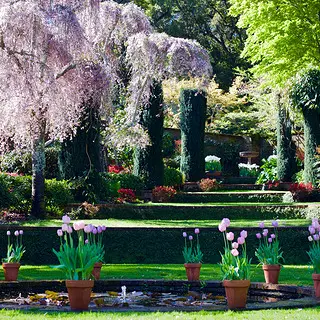
Garden Glory: A Virtual Tour of Four National Trust Historic Sites
National Trust Historic Sites are open! We encourage you to check directly with each site for up-to-date information on available activities, ticketing, and guidelines if you are planning a visit.
Plan Your VisitFor our third installment of the National Trust Historic Sites virtual tour series, we visit four estates that feature spectacular landscapes and gardens, Oatlands, Brucemore, Chesterwood, and Filoli (pictured above). While each of these sites has its own significant history, it’s an abundance of blooms that bring these places together. People who have been able to visit them in the spring and summer seasons often return again and again to bask in the serenity that only trees, shrubs, flowers, fountains, statuary, and garden paths can bring.
First, we visit Oatlands in northern Virginia and Brucemore in Cedar Rapids, Iowa.

photo by: Oatlands Historic House & Gardens
Oatlands’ property leads to the foothills of the Blue Ridge Mountains and offers a Virginia country experience complete with terraced gardens, barns, farmland, and a Greek Revival mansion. Located a leisurely carriage ride away from the nation’s capital when it was built in 1808, the estate continues to reflect the deep history of the region.

photo by: Matt Kraycinovich
The landscape at Oatlands today is very similar to the one designed by the property’s owner George Carter—whose wealth was based on the use of enslaved labor—in the early 19th century, thanks to the restoration efforts of Edith Eustis who lived there around a century later. Today the landscape features terraced gardens, statuary, and boxwood-lined parterres full of fragrant and colorful flowers.

photo by: Richard Roche/Flickr/CC BY-NC 2.0
Built between 1884 and 1886, Brucemore is a sprawling Queen Anne-style house located on a magnificent 26-acre park-like estate, where concerts, theater, and tours celebrate the heritage of a community. Located in Cedar Rapids, Iowa, the bucolic landscape with rolling yards, soaring trees, a timber-lined pond, and stunning gardens reflects the evolution of the property over more than 130 years through three different owners

photo by: Brucemore, Inc.
Brucemore’s second owners, the Douglas family made a series of significant changes that transformed the property into a model country estate. They expanded the acreage from ten to 33 and added many of the physical features still visible today. The Douglas family was also responsible for hiring landscape architect, O.C. Simonds, who embraced a philosophy of landscape design that celebrated plantings as they exist in nature, including natural forested areas.
Next we travel to Chesterwood in the Berkshires of Massachusetts and Filoli, a sprawling estate in northern California. Chesterwood is not only a National Trust Historic Site, as home and studio to the famed sculptor Daniel Chester French, the property is also part of the Historic Artists' Homes and Studios portfolio of sites. At 654 acres, the sheer size of Filoli makes it a complex site to maintain, so staff there have enlisted hundreds of volunteers who assist with a wide range of day-to-day activities including horticulture, botanical arts, and nature education.

photo by: Michael Lavin Flower
An 1898 country home, studio, and landscape, Chesterwood was the idyllic Berkshires estate of master sculptor, Daniel Chester French, who carefully designed an environment that would serve as his muse. His artistry and skills would lead to one of the nation’s most well-known works, the President Lincoln sculpture in Washington D.C.’s Lincoln Memorial.

photo by: Michael Lavin Flower
The Chesterwood landscape perfectly reflects Daniel Chester French and his interests; it is a combination of New England agricultural heritage and the influence of classical European ideals and culture. To complement his just-finished new Studio, French designed a formal garden in 1898. Soon after, he transformed an apple orchard on the property into an elegant perennial garden, which he took an active part in maintaining.

photo by: Filoli
Built between 1915 and 1917, Filoli is a 654-acre estate located about 30 miles from San Francisco. Originally the home of William Bowers Bourn II, Filoli has been a National Trust Historic Site since 1975 and is now recognized as one of the finest remaining country estates of the early 20th century.

photo by: Gretchine Nievarez
Landscape artistry brought worldwide recognition to the formal gardens that decorate this estate. Designed by California architect Willis Polk, this Georgian Revival mansion is surrounded by nature trails, manicured gardens, reflecting pools, and arbors designed to blend harmoniously with the nearby San Andreas hills.

photo by: Lucas Saugen
Filoli’s ten-acre Gentlemen’s Orchard contains some 600 fruit trees, about 114 of which date to 1918, when they were planted by the original owner, William Bowers Bourn II. Bourn considered himself a gentleman farmer and the orchard was a defining feature of the estate. Today, the orchard has more than 400 different varieties of apples, pears, and grapes as well as uncommon fruits such as medlars, quince, and shan zhas.
We hope you enjoyed our tour of National Trust Historic Sites landscapes and that spring blossoms in your neighborhood are reminder that, as the song says, “to everything . . . there is a season.”
Check out the rest of our virtual tours of National Trust Historic Sites, exploring places related to Commerce and Industry, Sacred Places, Architectural Traditions, Presidential Retreats, Modernism, and Southern History.
Donate Today to Help Save the Places Where Our History Happened.
Donate to the National Trust for Historic Preservation today and you'll help preserve places that tell our stories, reflect our culture, and shape our shared American experience.



